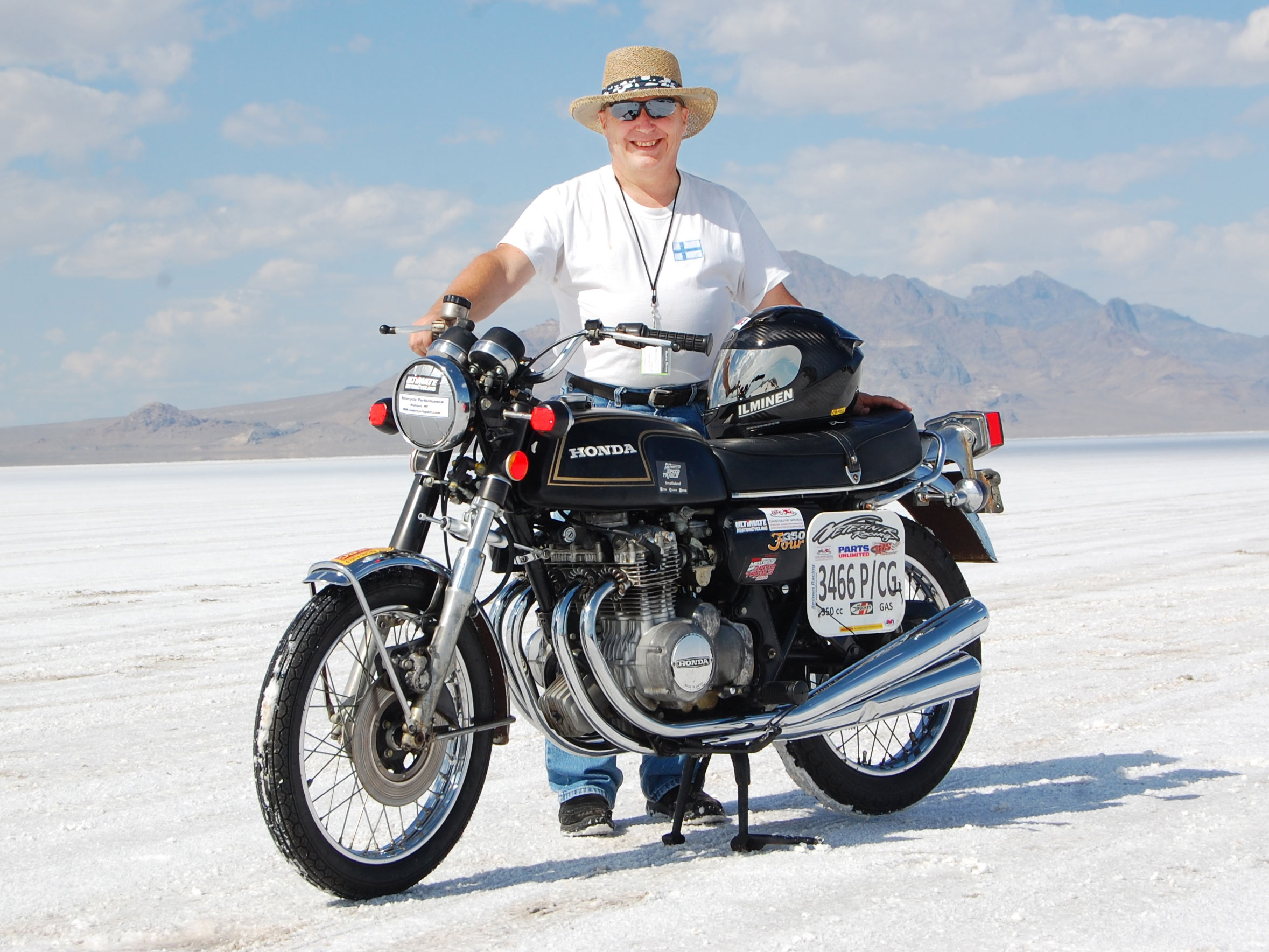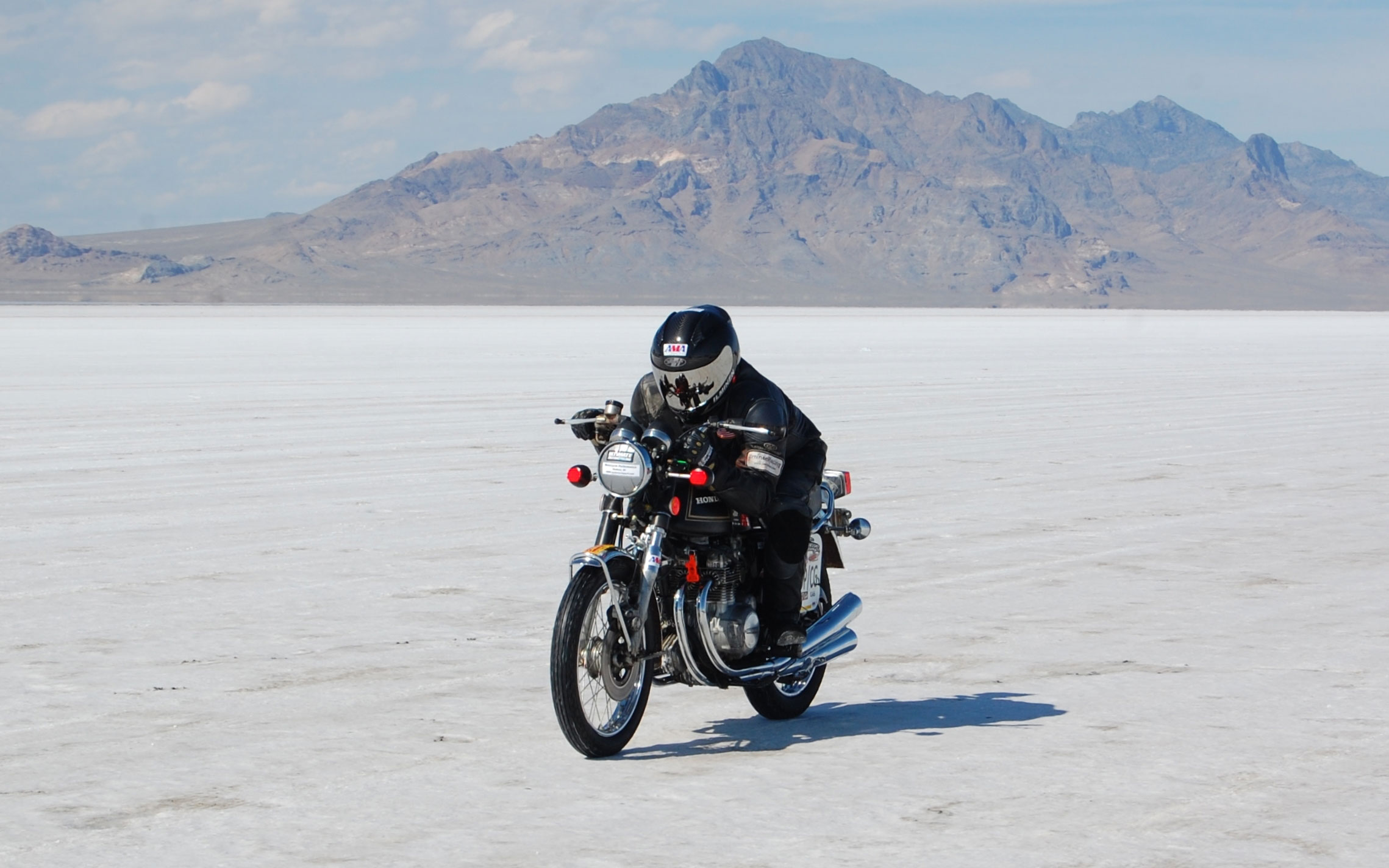American Motorcyclist August 2018
From Asphalt to Salt to World Record Holder
Gary Ilminen Among Privateers Who Set Records At Bonneville Motorcycle Speed Trials

By Michael Marino
For most people, salt is a common seasoning. For land speed racers, salt is the stuff of hallowed ground. For Gary Ilminen, the salt of Bonneville Speedway is where his interest in motorcycling kicked into high gear.
The 2018 AMA Land Speed Grand Championship is set for the Bonneville Speedway outside Wendover, Utah, Aug. 25-30, and Ilminen’s story demonstrates that a racer doesn’t need a factory budget or huge team to have a shot at setting a world record.
The Beginning
Even though he started riding at age 13, Ilminen is not the product of a motorcycling family.
“My dad used to tell the story of getting a ride from a buddy on a four-cylinder Indian many years ago,” he said. “He was deeply impressed by the power of that big machine, but never did own a motorcycle himself.”
Ilminen’s father nevertheless bought his son his first motorcycle when he was 13.
“My older brother, Randy, was the first in my family to own motorcycles,” he said. “When I got old enough to reach the pegs myself, he let me ride his Yamaha RT-2. My first powered two-wheel machine was a 2.5-horsepower HPE Cat minibike that my dad bought me in 1968.”
For Ilminen, taking the minibike out on the back roads of Iron County, Wisconsin and watching TV shows and movies like “Then Came Bronson” and Bruce Brown’s “On Any Sunday” fueled his interest.
Ilminen’s interest in Bonneville also started early.
“Seeing the late Don Vesco on the cover of the January 1971 issue of Cycle magazine after he set a world land speed record with his Yamaha streamliner at Bonneville added to the fascination with motorcycle sport in all its forms,” Ilminen said. “I was hopelessly hooked.”
Ilminen still owns 12 of the 28 motorcycles that have passed through his life.
But it took 35 years before his enthusiasm took him to his first high-speed ride on the iconic salt flats.
The Urge To Race
Ilminen’s childhood interest in land speed racing was rekindled when he met Bill Whisenant at a motorcycle event in southern Wisconsin.
Whisenant, the owner of Motorcycle Performance in Madison, told Ilminen about his racing efforts at Bonneville with Team MS Racing founder and Bonneville Racing veteran Jim Haraughty. Whisenant and Haraughty teamed up to race Ducatis at Bonneville for a number of years.
Ilminen told Whisenant about how fast he thought his Honda V30 Manga felt, and Whisenant invited him to join his and Haraughty’s team heading to the 2009 BUB Motorcycle Speed Trials.
“I was very thankful to be able to have the help of Bill and Jim at that first event,” Ilminen said. “They were terrific in helping me understand the flow of things during the event, the many ‘do’s and don’ts’ that are unique to competing on the salt and how to handle the bike on the salt surface.”
First Impressions
Ilminen’s first Bonneville experience exceeded his expectations.
“Just getting to Bonneville was a kid’s dream come true,” he said. “The photographs of the place I had seen 40 years before that fired my imagination really couldn’t do it justice. The vast expanse of white salt, dazzling blue skies and the mountains shimmering in the distance made for a stunning first impression.”
Racing is different at Bonneville because of its relatively thin salt surface. Some precautions are necessary that aren’t employed in other disciplines.
“For example, a tarp must be fastened down on the salt under your racing bike in your pit area to prevent any coolant or oil from being deposited on the salt surface,” Ilminen said. “Also, no permanent infrastructure is allowed out on the salt. Everything necessary to run the event is brought out there at the beginning and must be removed when it’s over. [The] AMA, as a member of the Save the Salt Coalition, [plays] an important role in restoring and preserving the Bonneville Salt Flats for the future.”
The track is laid out over the areas that are thick enough to bear the weight of vehicles.
“Venture out of those areas and you may break through into the mud and plunge into a very boggy and potentially expensive problem,” Ilminen said.
Despite having more than three decades of road riding experience, Ilminen found the salt to be a very different surface.
“At first contact, when you touch the salt surface, it is as rough as a rasp,” he said. “It would seem to offer incredible traction, until you realize that what you are feeling are nothing more than fragile salt crystals that are easily crushed under your bike’s tires. [This leaves] a very smooth and somewhat slick surface.”
In racing, there’s a common saying that smooth is fast. At Bonneville, smooth is both fast and a must for safety.
“The key advice to always follow with a motorcycle on the salt is ‘speed up slowly, slow down slowly, change direction gradually and brake gently,’” he said.
As a competition rookie on a 25-year-old bike, Ilminen didn’t think he would do well.
“My goals—apart from not crashing—were to see if the old Honda could top 100 mph and to gather information for an article about running a bike at Bonneville on a shoestring budget,” he said. “I didn’t actually think I had a serious shot at breaking the record.”
Ilminen missed the 500cc P/P Class record by 7.5 mph.
“The experience of my first 100-plus mph run down the salt flats—where so many legends of motorsports had competed—was unforgettable,” he said. “As I went through the 3-mile timer, I rose out of my speed tuck, gradually rolled off the throttle and soaked in the history and otherworld beauty of the place. I got so caught up in the moment, that I went too long before I finally turned off the course! A track marshal came over and asked me why I had run so long.”
A Change Of Bikes, Two World Records
Ilminen returned to the BUB Motorcycle Speed Trials at Bonneville the next year with a restored Honda CB350F to compete in the 350 P/P Class. His second visit resulted in a world record that he held for a short time.
“The bike actually held the production class record for a few days during that meet,” he said. “My top speed was easily topped by a much newer bike by the time the meet ended.”
Ilminen’s most recent trip to Bonneville, in 2014, was when he found lasting success.
That year, a new class was created for 350cc classic bikes (built in 1960-1980) for the AMA Land Speed Grand Championship. Ilminen showed up with his Honda CB350F and set the class record at 80.102, a record that still stands.
One More Time?
It’s been four years, but Ilminen said he is getting the itch to race on the salt again.
“After capturing a record in 2014, I had pretty much concluded that I’d never get back to Bonneville—at least not in motorcycle competition,” he said. “Since then, I’ve thought about the fact that Burt Munro (featured in the film, “The World’s Fastest Indian”) didn’t make his first appearance in competition there until he was older than I am now.
“So, after finding out that Whisenant and his team plan to return in 2019—the 10th anniversary of that first trip for me—I now think maybe it’s true that you should never say never.”
One of the things that most impressed Ilminen is the opportunity land speed racing presents for racers on a budget to be competitive.
“In land speed racing, it is still within reach for [amateurs] to achieve national and even world speed records,” he said.
Ilminen hopes more people will understand the important role the AMA plays in protecting and supporting the right to ride and race motorcycles.
“I can’t say enough about the importance of the role of the AMA in supporting amateur and professional motorcycle competition in keeping it safe, fair and accessible,” he said. “Beyond that, AMA has such a key role for motorcyclists, ATV riders and others in promoting safe riding, reasonable regulation, access and so many other aspects that are easy to take for granted.
“It’s important for riders to not only support the organization, but the mission.”


